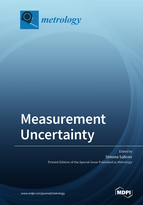Characteristic Function of the Tsallis q-Gaussian and Its Applications in Measurement and Metrology
Round 1
Reviewer 1 Report
This paper proposes a series of techniques to assess the probability distribution in linear measurement models. The paper is well-organized but here are several minor concerns.
1) Could author propose several potential application scenarios of this tool in real industry?
2) It is suggested to highlight more on the advantages/applications/significance of the proposed techniques.
3) More literatures can be reviewed.
Author Response
The response to the Reviewer 1 is in the attached file.
Author Response File: ![]() Author Response.pdf
Author Response.pdf
Reviewer 2 Report
Characteristic Function of the Tsallis q-Gaussian and Its Applications in Measurement and Metrology
Viktor Witkovský
This paper describes a computational technique that can be used to propagate input distribution functions, associated with the arguments of a linear model, to obtain the distribution function of the model output. The parameters of Tsallis q-Gaussian approximations to the distribution functions
I would like to see the paper published. I think it is well written and clear enough for interested readers to try the technique themselves. However, the way the technique is proposed as a general tool for evaluating measurement uncertainty is not acceptable.
The use of 'uncertainty' by the author refers to a particular approach to 'uncertainty' evaluation introduced in the first Supplement of the Guide to the Expression of Uncertainty in Measurement (SUP1). This is implemented in that document by a Monte Carlo method (MCM). However, the original Guide to the Expression of Uncertainty in Measurement (GUM) adopted quite a different approach. The essential difference being a different interpretation of probability. Most evaluation of measurement uncertainty today follows the GUM. Indeed, an attempt to change the original GUM to correspond to the alternative view taken in the SUP was rejected recently by the metrology community.
I suggest that the manuscript could be edited to remove more the general claims about 'uncertainty', making it clear that the intention is to provide an alternative computational procedure to the SUP1 MCM. If the author agrees, the Introduction should start by stating this limitation. For instance, the first sentence might be changed to something like "In the first Supplement to the Guide to the Expression of Uncertainty in Measurement, a method of evaluating measurement uncertainty is described consisting of three main stages: .... "
Other changes that would be needed are:
Section 1
* the reference to the GUM in line 32 should be removed. References to the supplements would remain.
Section 2
* The first and second paragraphs are problematic. These describe the GUM method of constructing an uncertainty interval. They do not apply to the SUP method. The paragraphs should be rewritten to use the view that the output distribution is a posterior distribution for the measurand, which the SUP uses to evaluate an uncertainty interval or region.
* In line 114, it would probably be better to say explicitly that CFA can be used to assess the distribution of the output, rather than refer here to uncertainty.
* Line 139, the sentence should not compare the CFA with the GUM method.
* Line 148, the claims of accuracy and efficiency will need to be justified (perhaps below in the paper).
* Line 154, the MCM is not necessarily good for non-linear problems. It would be wise not to make that claim.
Section 5
In this section differences are noted between the CFA and MCM uncertainty interval widths. There should be some statement about how accurate the MCM intervals are (based on the sample size). Then a more meaningful comparison can be made with the CFA results.
In section 5.4, the claim is made that the MCM result is inaccurate. This should be justified, perhaps by increasing the MCM sample size or some other means.
Line 346: please define what is a 'valid' result and how that would be different from an 'accurate' result.
As a general comment about the examples in this section, nothing in the examples is described (or would be recognised) as examples of typical measurement uncertainty problems. This strongly suggests that the method is being promoted by the author in terms of computing mathematical problems, not solving metrological problems. Because of this, it makes more sense to clearly associate the CFA with the SUP MCM.
Section 6
Line 360: please make it clear here that 'uncertainty' refers to the SUP interpretation of uncertainty.
Line 361: the claims of accuracy, flexibility and efficiency are made again, but have not been justified in the preceding text. Would, for instance, the CFA method be significantly faster than MCM? Please either remove these claims or add material to the manuscript to justify them.
Line 376: again the reference to non-linear problems and the MCM should be reconsidered (if the author insists on making this assertion, he should provide an explicit reference).
Author Response
The response to the Reviewer 2 is in the attached file.
Author Response File: ![]() Author Response.pdf
Author Response.pdf
Round 2
Reviewer 2 Report
I thank the author for considering the comments I made in the first review. The new manuscript is, in my opinion, much improved. I support its publication.
There is just one minor typo that I saw on line 109: the word "exists" should be changed to "exist".
Author Response
Thank you for taking the time to review the paper and providing valuable feedback.
The comment "There is just one minor typo that I saw on line 109: the word "exists" should be changed to exist" was accepted and corrected.





